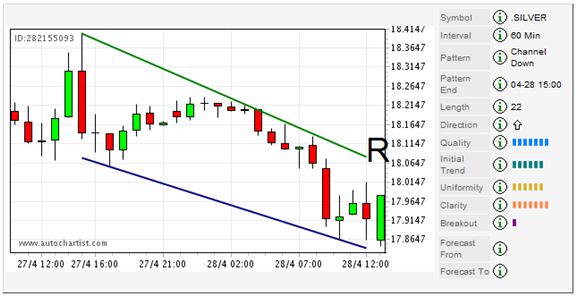6 Start up Tips for Autochartist
Trending patterns include rising/falling wedges and channels up/down. Continuation trending patterns are ideally traded when the market is uptrending or downtrending and when the Initial Trend reading is medium to high. Continuation entries can be swing entries off downtrend line resistance or uptrend line support. They can also be breakdown entries when the trending momentum is very strong and the market offers little to no correction.

The Falling Wedge pattern in this example has a high Initial Trend reading which indicates a continuation play set up. The Uniformity and Clarity are very strong and this shows that the pattern’s price action will be more reliable and less prone to whipsaws and random price action. Keep in mind that the time when this pattern has developed is important as well. If there is a pending economic release there is a high possibility of increased volatility.
The two primary entry considerations are:
- The short as prices exhaust at or near the downtrend line resistance (1) which would be a Autochartist Correction of the Trend entry (A.R.C.) or “swing” short;
- The downtrend line support (2) breakdown which would be a continuation breakdown entry. Since the Initial Trend is strong, the reversal would not be a primary trade consideration. Follow the trend. The trend is your friend, especially when the Initial Trend is high. Here it appears as if the price could allow for an A.R.C. or swing short (1).

If the Initial Trend is strong as in this example with the maximum of ten bars consider the breakdown play the more likely scenario (B).

When the Initial Trend is six or seven bars it is important to proceed with caution. Remember there still is some trend strength so there is the chance of a corrective or “swing” entry. The backbone of the pattern however could be tested and broken. In this case, the backbone or decision level is the downtrend line resistance (R). When the Initial Trend is six to seven bars indicating a weak trend there is less chance of the momentum continuation move lower through the bottom line of this downtrending pattern.
When the Initial Trend is low (less than six bars) but there is a trending pattern alert, it’s best forego that combination and instead look for a non-trending pattern alerts. Also consider however that the Initial Trend will also point to the likely entry strategy for the pattern based on the direction and strength of the current market direction.




